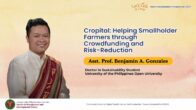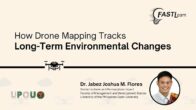Okay, so again, my name is Bench Gonzales, and in the next few minutes, I’d like to share a case of how a social enterprise or sustainable enterprise can address a specific facet of zero hunger, as well as encourage the average individual to contribute to the SDG with the added benefit of earning some profit.
So to achieve zero hunger, we must address problems across the system. One oft-neglected aspect of the food system is food production, or specifically, involving the people producing our food. So one of the goals of Zero Hunger involves doubling the agricultural productivity and incomes of small-scale food producers, including women, indigenous, family farmers and the like, and giving them access to financial services. So let’s see how this relates to the Filipino farmer and our case social enterprise. So poor, aging, and under-educated.
You may think that these are unlikely descriptors for hardworking individuals who take the risk of growing the food that we eat. Yet around the world, this is a reality. In the Philippines, wages for agriculture are lower than for non-agriculture jobs, with their average basic pay being less than half of the current Metro Manila minimum wage, which is P610.
Ironically, this results in a third of those responsible for our food or growing our food, not being able to afford food and other basic necessities. Among all the sectors, farmers have the highest poverty incidence. The average poverty incidence in the country is 18%. The average age of 56 means that many farmers are still working beyond their retirement age and that less and less young people are engaging and farming.
In terms of education, the average farmer has likely not even finished high school education. And on top of that, most of us in urban areas are oblivious to the plight of these farmers on a daily basis. We are disconnected to those who produce our food. According to the farmer empowerment nonprofit, Philseed, in 2023, some challenges faced by farmers include access to capital, lack of post-harvest facilities, and climate change, market access, and lack of innovation. For access to capital, only 6% of bank loans go to the agricultural sector. Those who don’t have access to banking and microfinancing organizations sometimes end up borrowing from predatory informal lenders who charge as much as 10% monthly interest. That’s way bigger than your credit card interest.
And the infamous 5-6 loan sharks who charge 20% interest for a fixed period of time, sometimes as short as a few weeks. Farmers also suffer from post-harvest losses, mostly because of the lack of post-harvest facilities for transit and storage. This is also being aggravated by climate change. Changes in climate and weather patterns such as increased frequency and intensity of storms resulted in bigger damages to crops and farmlands. A single typhoon in 2021 cost over 10 billion pesos or $250 million worth of damage to agriculture. And lastly, the overall agricultural productivity is only 1.7% and is not keeping in step with our population growth rate.
Couple that with the decreasing proportion of land used for agricultural activities and we have a case of farming in the Philippines which has indeed become a challenging profession. So just a disclaimer, I am not affiliated with Cropital although we were able to interview their founder in 2022. Also recently I was able to try out their investing platform although I am yet to complete a round of investments so I’m yet to see the returns so to speak on the investment I made.
So Cropital is a portmanteau of the words crop and capital. They are a social enterprise that focus on funding smallholder farmers. The company was founded by Ruel Amparo in 2015 at the young age of 22. He has actually recently been awarded as one of the outstanding young men or TOYM for 2023 by the Junior Chamber International. And apparently he is also the CEO of another agritech social enterprise, Agrilever, which we cannot cover today. So Cropital is a crowdfunding platform, if you’re familiar with crowdfunding, that is where you get funds from multiple individuals for a certain purpose, usually through online means. And they help smallholder farmers gain access to scalable and sustainable financing. They have raised so far over 100 million pesos in crowd funds and have supported over 1,600 farmers across 10 provinces in the Philippines.
In a nutshell, they allow investors with as little as P5,000 to spare to support farmers who are looking for low-interest financing while also helping them in other farming-related aspects, as we will discuss later. Cropital is also globally recognized and supported by institutions in the USA, the Netherlands, Malaysia, and the Philippines. So how does it work? You go to their website and then you create an account. Then you can view the selection of farms. You can fund in increments of 5,000 pesos or 88 US dollars. And once a farm is fully funded, you will be sent a memorandum of agreement covering the legal details of your transaction. Cropital then manages the funds for the farmer to make sure they are after the produce have been harvested and sold, the capital and profit will be credited to the investor’s virtual wallet at the rate of 3 to 30% ROI within 4 to 6 months. So for example, if that’s 30% in 4 months, then that’s 90% in a year.
But of course, that’s more like the exception rather than the norm. In my case, I got a 3.5% ROI my contract. Okay, so if you click the farmer display profile, it shows the details about the farmer, what they plant, their location, and it also shows what the money will be used for. Usually this is for seed fertilizer and labor. And as you can see, there’s also a section about how your investment could help improve their lives or become a better alternative for them.
And you can also see that most farmers have other jobs, whether part-time or full-time, such as employee, fisherman, carpenter, vendor, business owner, and the like. And this just goes to show that full-time farming is not a good option for most of the farmers at this point. They also show the potential impact of indirectly supporting other individuals benefiting from the farmer being supported.
So in this case, there are 13 other jobs in the community that can be generated by supporting that single farmer. In other cases, it’s as high as around 25. And as for the risk management part, a number of steps have been taken to minimize investment risks. Farmers are verified and selected with LGU assistance to avoid unscrupulous individuals. And they also have developed an assessment tool or algorithm based on past information and the help of experts’ inputs to help in predicting farmer credibility as well as gauge how big a loan a certain farmer can take on. Crop insurance is also provided through the Philippine Crop Insurance Corporation. And Cropital assists the farmers with paperwork and also require their affiliate farmers to be insured.
They also have loan insurance in case something happens to the borrower during the loan period, management and prevention, best practices. Capital also links them to various individuals and groups to help them in other areas of farming, such as in marketing their produce. Market risks are also reduced through the diversification of crops and the clustering of farmers to distribute the risk. And then investor risks are also reduced by capping the amount that a single investor can invest on one farm.
So to speak, they’re forcing you to not put your eggs in one basket and encourage diversification. So allow me to share with you some of my realizations from these. First, social enterprises can be made to help very specific sectors. In this case, they focused on small farmers looking for alternative funding loan sources.
Second, just like any business, you must have a demographic in mind for your customer base. In this case, it’s those with a little money to spare for short to medium term investments like the same people who would invest in digital banks, unit investment, trust funds, or stocks and cryptocurrency platforms.
Next, the social enterprise took advantage of emerging technology such as crowdfunding to disrupt the traditional and predatory loan sectors. Next, one major difference between their approach and traditional microfinancing non-government organizations is that they pitch an investment product rather than ask for donations. This helps against donor fatigue and can even divert money earmarked for investment towards a social cost.
Lastly, based on our interviews with them, social enterprises are new and those engaging in them should be willing to learn as they go or blazing the trail. Things will not go smoothly. There aren’t many business models or templates when you are innovating. And as you interact with beneficiaries, you get to refine the system and process to be more aligned with their mission and vision. And then although their primary objective is to finance farmers, there’s also the opportunity to help them transition into more sustainable farming methods, hopefully without compromising their ability to provide for their needs.
So if you’re interested to learn more or invest, you may visit their website at cropital.com or you may want to check out the two-part interview we did with them in our podcast.It’s about 30 minutes each. And these are the references I use for the farming issues and statistics. And that will be all. Thank you for listening.

























